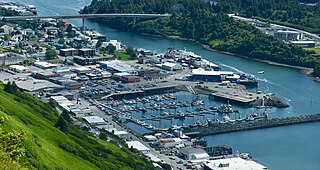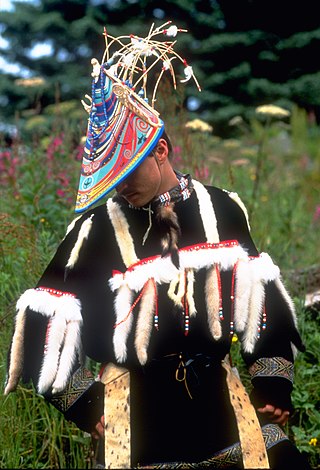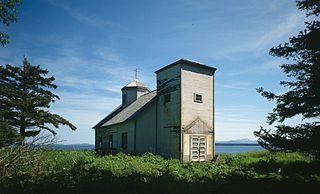
The Russian colonization of North America covers the period from 1732 to 1867, when the Russian Empire laid claim to northern Pacific Coast territories in the Americas. Russian colonial possessions in the Americas are collectively known as Russian America. It consisted mostly of present-day Alaska in the United States, but also included the outpost of Fort Ross in California, and three forts in Hawaii, including Russian Fort Elizabeth. Russian Creole settlements were concentrated in Alaska, including the capital, New Archangel (Novo-Arkhangelsk), which is now Sitka.

The City of Kodiak is the main city and one of seven communities on Kodiak Island in Kodiak Island Borough, Alaska. All commercial transportation between the island's communities and the outside world goes through this city via ferryboat or airline. As of the 2020 census, the population of the city is 5,581, down from 6,130 in 2010. It is the tenth-largest city in Alaska.

Old Harbor is a city in Kodiak Island Borough, Alaska, United States. At the 2010 census the population was 218, down from 237 in 2000.

The Alutiiq people, also called by their ancestral name Sugpiaq, as well as Pacific Eskimo or Pacific Yupik, are one of eight groups of Alaska Natives that inhabit the southern-central coast of the region.

Kodiak Island is a large island on the south coast of the U.S. state of Alaska, separated from the Alaska mainland by the Shelikof Strait. The largest island in the Kodiak Archipelago, Kodiak Island is the second largest island in the United States and the 80th largest island in the world, with an area of 3,595.09 sq mi (9,311.2 km2), slightly larger than Cyprus. It is 160 km long and in width ranges from 16 to 97 kilometers. Kodiak Island is the namesake for Kodiak Seamount, which lies off the coast at the Aleutian Trench. The largest community on the island is the city of Kodiak, Alaska.

Grigory Ivanovich Shelikhov was a Russian seafarer, merchant, and fur trader who perpetrated the Awa'uq Massacre.

Afognak is an island in the Kodiak Archipelago 5 km (3.1 mi) north of Kodiak Island in the U.S. state of Alaska. It is 43 miles (69 km) long from east to west and 23 miles (37 km) wide from north to south and has a land area of 1,812.58 km2 (699.84 sq mi), making it the 18th largest island in the United States. The coast is split by many long, narrow bays. The highest point is 2,546 feet (776 m).

The Kodiak Archipelago is an archipelago south of the main land-mass of the state of Alaska, about 405 km (252 mi) by air south-west of Anchorage in the Gulf of Alaska. The largest island in the archipelago is Kodiak Island, the second-largest island in the United States. The archipelago has a length of about 285 km (177 mi) and a width of about 108 km (67 mi), from the Barren Islands on the north to Chirikof Island and the Semidi Islands group on the south. The archipelago contains 13,890 km2 (5,360 sq mi) of land. The Kodiak Archipelago contains about 40 small glaciers, numerous streams and many species of land and marine animals. Much of its land is forested.

Afognak (; also Agw'aneq in Alutiiq was an Alutiiq village on the island of Afognak in Kodiak Island Borough, Alaska, United States. It was located on Afognak Bay on the southwest coast of the island, three miles north of Kodiak Island. The site is now within the CDP of Aleneva.
The Native Village of Afognak is a federally recognized Alutiiq Alaska Native tribal entity, originally native to the island of Afognak.

Southwest Alaska is a region of the U.S. state of Alaska. The area is not exactly defined by any governmental administrative region(s); nor does it always have a clear geographic boundary.
Sitkalidak Island is an island in the western Gulf of Alaska in the Kodiak Island Borough of the state of Alaska, United States. It lies just off the southeast shore of Kodiak Island, across the Sitkalidak Strait from the city of Old Harbor. The island has a land area of 300 square kilometers (120 sq mi) and no resident population.

A barabara or barabora (Russian); ulax̂, ulaagamax, ulaq, or ulas (plural) (Aleut); and ciqlluaq were the traditional, main or communal dwelling used by the Alutiiq people and Aleuts, the indigenous people of the Aleutian Islands. They lay partially underground like an earth lodge or pit-house, and most of the house was excavated from the dirt so as to withstand the high forces of wind in the Aleutian chain of islands. Barabaras are no longer used, as present-day Aleuts live in modern houses and apartment buildings.
The Alutiiq language is a close relative to the Central Alaskan Yup'ik language spoken in the western and southwestern Alaska, but is considered a distinct language. It has two major dialects:
Koniag is one of twelve Alaska Native regional Corporations created under the Alaska Native Claims Settlement Act of 1971 (ANCSA) in settlement of aboriginal land claims. Koniag was incorporated in Alaska on June 23, 1972. Headquartered in Kodiak, Alaska, with additional offices in Anchorage, Koniag is a for-profit corporation with about 4,300 Alaska Native shareholders primarily of Alutiiq descent.
The Shelikhov-Golikov Company (SGC) was a Russian fur trading venture, founded by Irkutsk entrepreneurs Grigory Shelikhov and Ivan Larionovich Golikov in 1783. Formed in Eastern Siberia during the 1780s along with several competing companies, the SGC had operations in Kurile Islands and areas that later became Russian America. Russian ventures had been focused on maritime operations under promyshlenniki, though costs had continued to rise as more distant sea otter populations had to be exploited. Centered on the Kodiak and several Aleutian Islands, the majority of the company's indentured laborer was recruited among the Aleut and Alutiiq nations. A common practice amongst Russian companies was to take hostages from various villages, to force maritime hunters to gather otter furs. Shelikhov led aggressions on Kodiak Island against the indigenous Alutiiqs in 1784, known as the Awa'uq Massacre, where Russian employees killed over 2,000 people according to some estimates. In consequence of the massacre, the Island became fully controlled by the company.
Sven Haakanson, Jr. (Alutiiq) is an American anthropologist who specializes in documenting and preserving the language and culture of the Alutiiq. He served, from 2000-2013, as Executive Director of the Alutiiq Museum in Kodiak, Alaska. He is a Professor of Anthropology at the University of Washington, Seattle, and Curator of North American Anthropology at the Burke Museum. In 2007 he was named as a MacArthur Fellow for being a leader in the effort to rekindle Alutiiq language, customs and culture.

Henrik Johan Holmberg or Heinrich Johann Holmberg was a Finnish naturalist, geologist (mineralogist) and ethnographer. He was the first recorder of the Awa'uq Massacre in the Russian America of Shelikhov-Golikov Company. Henrik Holmberg followed in 1851 to document an evolved origin story and several other stories as told by Arsenti Aminak.
The Alutiiq Museum or Alutiiq Museum and Archaeological Repository is a non-profit museum and cultural center dedicated to preserving and sharing the cultural traditions of the Koniag Alutiiq branch of Sugpiaq ~ Alutiiq of the Alaska Native people.
The Russian Empire began its interest of the Pacific Northwest in the 18th century, initially curious if there was a land connection between the Eurasian and North American Continents. Two expeditions were led by Vitus Bering, with the findings proving the separation of two continents through the Bering Sea. Being the first European nation to chart much of what comprises the modern American state of Alaska, many locations retain Russian place names. The discovery of sizable fur bearing populations by Bering drew the attention of promyshlenniki previously engaged in the Siberian fur trade. Based out of the Siberian ports of Okhotsk or Petropavlovsk, fur trappers sailed and reported the location of land formations like the Aleutian Islands, Kodiak Island and portions of the Alaskan mainland. Relations with Native Alaskans was often terse due to the uncontrolled actions of particular promyshlenniki who killed and raped Indigenous Alaskans on islands they trapped furs.












